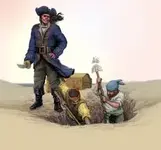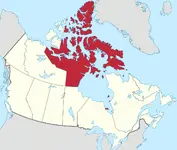That is interesting info Robot thank you.
I recently read up on the information about Kydd being exonerated Post Mortem, and also into his movements while being accused of Piracy, AND murder for the death of a mutinous sailor by bucket to the head....it was clearly not him in the area.......and his men went on to surrender their ship.......
I didnt hear anything about him being near the area in Nova Scotia, and all of his men where accounted for.......except a couple of mutineers
What is remarkably
strange is the tale of the Impossible Walk of David Ingram, English Explorer.
He was known to have been Pirating in 1588 under charter for England, and was off the coast of Mexico, Tampico Bay, he was faced with starvation so his men went ashore. A few went south fleeing native attack and fell into Spanish captivity, returning some 10-25 years later, and the rest either were killed by natives, or traveled north on a 3000 mile journey.
What is not only remarkable, is the walk they made, having had made a pacce at over 8 miles per day for 11 months straight, with all of their packs, AND the treasures they had been looting, BUT then to be picked up off the coast of Cape Breton by a French Sailor, M. Champaigne....
.......not Samuel Champlain, who came later to then "Christen the Lake".
What is
stranger than all that, is the descriptions of animals and cities they passed, matching the coast, and how they were able to SURVIVE all this w/ the Natives helping them along.....
This only can be attributed to the trade they had made of their gold and silver, and jewels, for food, along the way that was shown to them to travel to the next town through the Native American Trails they walked.
This tale of a harrowing journey left only 5 men to make it to NOVA SCOTIA of all places
?
Then when home it becomes an incredible journey fabricated when they return. They comments by the regents of the times who were looking for info, hearing about this trip's failure under Charter were searching in England for Ingram and were not able to find him for 13 years..........and when finally questioned, they noted "as if he was lying, and exaggerating the story of his trip, to overlook the guilt of his tales."
Make this into the scene we have found here....he's under commission, and fails to report the death of his men, and disappears for over a decade hiding under their noses
The Charter was able to turn over 100 men.........into a five man crew that only the Captain and his closest men, are found having camped 60 leagues west of Cape Britton, HMMMMMMMMM, and had just come from the west making their FIRST DISCOVERY OF A RESCUE VESSEL in over 3000 miles??
60 leagues from the peninsula they were found on is 180 miles...........EXACTLY where Oak Island is.....and where the English Burton Block is hung there to remind them?
This is completely obvious who these Pirates were, and why they were there, having set a second trove there as well, where one of the descendents of these men later handed a early 1900's searcher a tale.......of seeing a map of another location some leagues away that these same pirates had left......
.....the Captain and his first officers were the only left
? and where were the rest of the labor he had taken to Pirate......
Dead he says.....??
So now we have another Pirate tale to add of "Dead Sailors" in the area, men who could have easily been there for that entire time digging their own Money Pit, having stolen their booty from the others and fled back there to use as a leap point closer to England, while continuing their racket in the ports.
These were Englishmen, who set out in 1598 to Pirate..... and they were found having been camping out there with little of nothing to leave behind??....a few coins dropped in memory is my theory, like a wishing well in the swamp............
The newest find these days is the Pirate Camps they found in the area on Cape Breton, further around the coast from where they were found......and there were that many men rumored to be there camping as Pirates, according to the size of the area they found recently. They said there is a whole nother area to be looked at for troves, as these men lived and died there.......building an artificial pier and docking ramp....
and here comes the kicker.......these were the men who stayed behind to settle there, having been secretly preparing to Pirate the same year as the Spanish Armada was invading England, and they had decided to become rogue Pirates against whoever that came by.
Under the French command that would have rescued the Captain David Ingram and his 4 men, they would have reported this to their French Naval leaders....M. Champaign would have told his superiors about their rescue of Pirates. This sets up the original tales of Piracy that were in violation of these Naval Laws and Territorial laws, that led to the original conflicts concerning these Naval Wars,
and after they started this English Piracy Policy, they went into the wars with the French and Spanish till they
a perfect cover to Dupe everyone into thinking that this trove would be some Pirate Coins in a ditch.........
......The troves they stole might be buried there, up in the hills of Annapolis, or even in the other area, some feet away from the pit.....close to the shore....,
In the early and mid 1590's, Samuel Champlain is on his journey, mapping the areas all the way to Central America, with the Spanish
Champlain was on his journey mapping when he was actually ordered to return shortly after 1598, when David Irving was rescued. This is the same year that Champlain was then sent out on the "Special Mission for the King".......under the guise of a Pirate Treasure there on Oak Island, they crafted something to relate to the area, having found the Trove and adding to a few hidden Pirate clues, planting
their actual troves elsewhere, while landscaping the areas to appear like someone was there, and while adding other clues to the other Islands....
Like the buried Nolan Cross Stones, and other stones with scale references.......the Birds Head Rock and the Cornerstone, The Drilled Stones as well.
The Pirate clues are all there........as are the others around them.....












